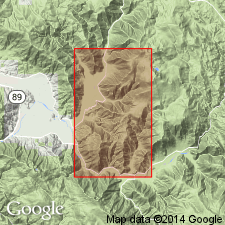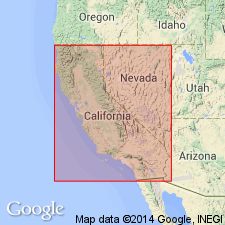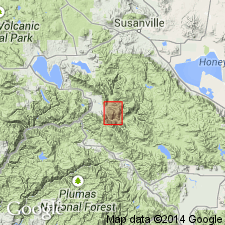
- Usage in publication:
-
- Bicknell sandstone
- Modifications:
-
- Named
- Dominant lithology:
-
- Sandstone
- AAPG geologic province:
-
- Sierra Nevada province
Summary:
Unit is named the Bicknell sandstone. Consists of light-gray or bluish gray sandstone, sometimes tuffaceous. Thickness is 500 feet. Overlies the Hinchman tuff; underlies the Morman sandstone. Age is Late Jurassic. (B896)
Source: GNU records (USGS DDS-6; Menlo GNULEX).

- Usage in publication:
-
- Bicknell sandstone*
- Modifications:
-
- Adopted
- AAPG geologic province:
-
- Sierra Nevada province
Summary:
Bicknell sandstone of Diller (1892) is adopted. Chiefly red and gray sandstone associated with some dark shales and tuffaceous beds. Brownish-red sandstone forms earliest part of formation. Middle part is compact, fine, dark-gray sandstone interbedded with black shaly beds. Upper part consists of tuffaceous gray sandstone. Thickness 500 to 1,300 feet. Overlies, probably conformably, Mormon sandstone and grades into overlying Hinchman sandstone. Age is Late Jurassic.
Greatest development on southeastern slope of Mount Jura, Plumas Co., Taylorsville region, northern CA.
Source: US geologic names lexicon (USGS Bull. 896, p. 179).

- Usage in publication:
-
- Bicknell sandstone
- Modifications:
-
- Not used
- AAPG geologic province:
-
- Sierra Nevada province
Summary:
Rocks of the Bicknell sandstone (Diller, 1892) are included in the Hinchman sandstone. Age is Late Jurassic.
Source: GNU records (USGS DDS-6; Menlo GNULEX).

- Usage in publication:
-
- Bicknell sandstone*
- Modifications:
-
- Mapped
- AAPG geologic province:
-
- Sierra Nevada province
Summary:
Shown on paleotectonic map as underlying the Hinchman sandstone and unconformably overlying unnamed volcanic rocks that overlie the Mormon sandstone.
Source: GNU records (USGS DDS-6; Menlo GNULEX).

- Usage in publication:
-
- Bicknell Sandstone*
- Modifications:
-
- Age modified
- AAPG geologic province:
-
- Sierra Nevada province
Summary:
Age of the Bicknell Sandstone is revised from Late Jurassic to: Middle Jurassic (Callovian) based on fossils.
Source: GNU records (USGS DDS-6; Menlo GNULEX).
For more information, please contact Nancy Stamm, Geologic Names Committee Secretary.
Asterisk (*) indicates published by U.S. Geological Survey authors.
"No current usage" (†) implies that a name has been abandoned or has fallen into disuse. Former usage and, if known, replacement name given in parentheses ( ).
Slash (/) indicates name conflicts with nomenclatural guidelines (CSN, 1933; ACSN, 1961, 1970; NACSN, 1983, 2005, 2021). May be explained within brackets ([ ]).

